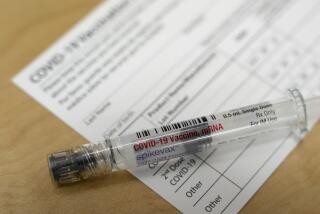Broad Impact Seen for New Nasal Flu Vaccine
- Share via
WASHINGTON — An experimental influenza vaccine delivered through a nasal spray has worked extremely well in a trial among healthy young children and “could have a significant impact on public health,” the National Institutes of Health reported Monday.
The vaccine not only induces a broader immunity than current vaccines, but it also is far easier to produce in large quantities and easier to administer. That means it could be made available to many more people, potentially reducing transmission of the virus each year.
“The initial results from this trial are very exciting,” said Dr. Anthony S. Fauci, director of the National Institute of Allergy and Infectious Diseases. “An influenza vaccine given in a nasal spray would be easier to administer and more acceptable than an injection, especially to children.”
Each year, between 35 million and 50 million Americans contract flu, and more than 20,000 people die. The economic cost of influenza can be high: A severe epidemic, including more than 172,000 hospitalizations, would cost at least $12 billion in medical expenses and lost productivity.
The experimental vaccine was developed and refined over several decades by researchers at the University of Michigan School of Public Health, the infectious diseases institute and Aviron, a biopharmaceutical company in Mountain View, Calif.
Aviron plans to begin another study this fall in healthy working adults and expects to submit a licensing application with the Food and Drug Administration next summer. Pending FDA approval, the company intends to make the vaccine available by prescription in the United States for vaccination campaigns in the fall of 1999.
Administered through tiny squirts of spray in each nostril, the vaccine induces a broader immunity than injected vaccines because it enters the body through the mucous membranes of the nose and follows the natural route of an infection, said John La Montagne, director of the institute’s division of microbiology and infectious diseases.
Dr. Brian Murphy, a researcher at the institute who has studied the vaccine for many years, said the new vaccine “can’t grow at warmer temperatures found in the lower respiratory tract, but it grows well in the cooler nasal passages--this allows the vaccine to mimic a natural infection and induce immunity without actually causing disease.”
*
The potential for much wider production of the new vaccine also has scientists excited. Unlike the current injectable vaccine, which is made from killed viruses, the experimental vaccine is made from a weakened strain of live virus.
Eggs are used as the medium to grow both types of vaccines, but one egg produces only one dose of the injectable product, while a single egg can produce 1,000 doses of the nasal vaccine, La Montagne said.
“So now you have a vaccine that is easier to produce and can be given by nose drops,” he said. “Someday, you might be able to get a prescription from your doctor, and even administer it at home.”
Perhaps the greatest effect would be on children, who have a flu “attack” rate of two to 10 times that of adults. By age 5, most children already will have suffered two or three bouts.
However, the flu does not pose a serious health risk to children, so they are not routinely given the current vaccines, which are in short supply. Instead, those vaccines typically go to adults and to groups with a high flu mortality rate, such as the elderly and those with diabetes, chronic pulmonary afflictions and other health conditions.
“Kids already get a lot of shots, and kids, for the most part, do pretty well with the flu--it’s miserable and a nuisance, but they don’t die from it--so they haven’t been as high a priority for getting the current vaccine,” La Montagne said. “The supply issue historically has been a real problem.”
But because children suffer so many bouts of the flu, they are a major conduit of infection to the entire population. Public health officials believe that preventing flu in kids could play a big role in reducing overall transmission and incidence of the disease.
Researchers hope that once the nasal vaccine is licensed, it ultimately can be administered to children and healthy adults, and given along with the injectable vaccine to high-risk individuals.
Like the current vaccine, the nasal type would have to be administered annually and would be changed every year to conform to the predominant strains of flu that are in circulation. There are two types of influenza--Type A and Type B. But the strains vary from year to year, and immunity from one strain will not protect against a different strain.
The trial, conducted with children ages 15 months to 6 years, found that only 1% of the 1,070 children who received the vaccine during last year’s flu season developed flu, as compared to 18% of the 532 children the same age who received a placebo.
The currently licensed flu vaccine is between 70% and 90% effective in individuals younger than 65.
The pediatric trial began late last summer and was scheduled to last two years. However, enough influenza cases developed among participants, prompting researchers to “unblind” the study and evaluate the results early.
“This is the largest well-controlled field trial of any influenza vaccine in this age group,” said Dr. Robert B. Belshe, who chaired the study and is director of the center for vaccine development at Saint Louis University in Missouri. It was important to do an efficacy trial in a group that was not already being protected through vaccination, he added.
*
The study was conducted at 10 sites nationwide, including Harbor-UCLA Research and Education Institute in Torrance. Dr. Ken Zangwill of the Harbor-UCLA facility said he was “very excited about the results and about the prospects of giving a needleless vaccine to children for one of the most common viral infections of childhood.”
Zangwill, whose center studied 60 Southern California children enrolled in the trial, agreed that the results held “substantial public health implications for stopping the spread of influenza.”
(BEGIN TEXT OF INFOBOX / INFOGRAPHIC)
Alternative to the Needle
One of the advantages to the nasal flu vaccine is that it attacks viruses in the nasal passages, the point of entry in most flu cases.
How Flu Spray Works
* Vaccine attaches to receptors in nasal passages.
* It mimics a natural infection and creates antibodies, which produce immunity in the nose and the rest of the body.
Dosage: Two squirts once a year, by prescription only.
Other advantages: Ease of use, particularly for children, who typically spread the flu to adults.
When available: If approved, could be ready for fall 1999.
Sources: Aviron, National Institutes of Health; researched by CHRIS ERSKINE / Los Angeles Times






